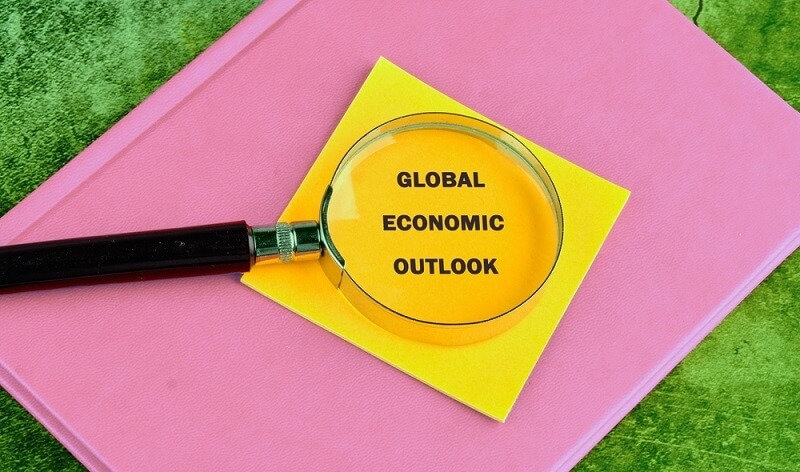
With 2025 fast approaching, the global economic outlook for 2025 is front and center for economists, governments, and investors. The starting signals indicate a mixed economic outlook in the future, with recent signs of global recession in 2025, evolving trade policies; and heightened volatility in emerging markets forecast for 2025. The shifting picture can be both a dilemma and an opportunity for American investors.
It is important to be aware of the macroeconomic forces underpinning the 2025 world economy prediction USA to make the best investment decisions and navigate global markets with ease.
In this blog, we explore the key trends that will drive the global economy in 2025 and how they will affect U.S. markets, your investment portfolio, and the value of the dollar internationally. Whether you are an institutional investor or retail trader, this report will keep you at the front end.
The global economic outlook 2025 is more than just a projection, it is a plan for savvy investing. With markets changing and risks increasing, U.S. investors must act decisively and quickly.
As we approach Early 2025, the specter of a global recession looms beyond our scope, very real as of early 2025. While not every indicator points toward recession, the 2025 global recession indicators are certain in many important areas:
The International Monetary Fund (IMF) indicates worldwide GDP growth to be between 2.1% and 2.5%, which is a staggering drop from the post-pandemic recovery years.This is in part because of the restricted monetary policy by central banks battling inflation as well as weakening global trade momentum.
For U.S. investors, a slowdown globally would put pressure on multinational profits, affect exports, and drive equity and bond market volatility.These indicators recommend how investors can reallocate exposures across global equities, fixed...
The domestic USA economic outlook for the 2025 world economy projection is a mixed bag. The positive is that job creation is steady, wages are stable, and consumer consumption is very healthy. Conversely, high interest rates and rising debt servicing costs are beginning to cut into it, most notably in real estate and consumer credit.
Even in the face of external headwinds, the U.S. economy will grow about 1.8% in 2025, ahead of many other advanced economies. For investors, this underlines the attractiveness of domestic assets, especially defensive sectors like utilities, healthcare, and dividend-paying stocks.

The global dollar strength U.S. impact will continue to be a defining characteristic of the global economic forecast 2025. The dollar has maintained its advance on the strength of high interest rates, relative economic strength, and status as a safe haven in times of geopolitical tension.
While a strong dollar benefits U.S. consumers and importers by making foreign products cheaper, it is problematic for emerging markets:
For investors, a strong dollar can have an impact on diversification of the portfolio, specifically in foreign equities and bonds3. Hedging currency risk or focusing on US multinationals with substantial global revenues may be a smart strategy.
The emerging markets outlook for 2025 is shaped by asymmetrical recovery patterns, inflation, and political headwinds. India and Indonesia are emerging with strong domestic demand, technology adoption, and good demographics. Argentina, Turkey, and South Africa face severe macroeconomic imbalance, with declining currencies.
Here are the notable takeaways for investors:
Emerging markets present a more lucrative growth opportunity but have much greater risk. US investors who are thinking about placing funds here should focus on diversified mutual funds or ETFs, with a focus on operationally sound markets with monetary stability and policy reform.
The Economic Trade Policy even before 2025 is changing in a tectonic shift. Globalization transitioned to regionalization at a rapid pace. In addition, nearshoring and national interest-first politics will be fully in effect.
These policy changes have investment ramifications; while U.S. manufacturers, logistics companies, and firms involved in infrastructure investment may benefit, businesses with disproportionate reliance on Chinese supply chains are likely to be disrupted.
The commodities markets dominate the global economic outlook for 2025. While inflation has come down from the peaks reached in 2022–2023, energy prices and raw materials remain volatile due to global tensions and supply_constraints.
This presents a favorable circumstance for investors that can employ a diversified strategy of commodity ETFs, equities in the energy sector, and inflation-indexed securities.
Despite macroeconomic turbulence, technological innovation is a positive development in the 2025 economic outlook for the USA and the world. Sectors like AI, quantum computing, renewables, and fintech continue to be potential draws for investors.
These trends create long-term prospects for U.S. investors focused on disruptive innovation through growth focused mutual funds orator based ETFs
No assessment of the global economy 2025 could be complete without some consideration of geopolitical tensions.Conflicts in Eastern Europe, the Middle East, and East Asia will likely have an effect on energy markets, trade, and investor confidence.
Forecasting these events is very difficult; however, the market outcomes will be important. Investors need to remain alert to signs of risks and have a portfolio that has defensive positions and also growth exposure.
When looking ahead to 2025 for the world economy, U.S. investors should consider the following strategies:
Remember that volatility creates opportunity. With disciplined planning and a global mindset, investors can succeed and prosper even in uncertainty.
A mixed bag of opportunity and risk awaits investors in the global economic outlook for 2025. Indicators of global recession 2025, rapidly changing trade flows, potential effects of U.S. dollar appreciation, global effect on foreign markets contributing to increased isolationist policies, are all part of a range of prospects that require a great deal of caution, insight, and timely tactical response from investors. The U.S. remains a relatively good economic anchor, but no market can consider itself an island. International linkages, especially with emerging markets forecast for 2025, are particularly critical for investors to monitor.
As we move forward into 2025, knowledge of macroeconomic developments, trade policy changes, and developments in the investment community is the most crucial investment to protect against risk and opportunity costs and help position portfolios more securely to ride out uncertainty while also seizing opportunities.
Your knowledge is your best tool, especially when you are an institutional manager, long-term investor, or retail investor. Know what you need to know and use it wisely to determine your allocation and acumen.
This content was created by AI